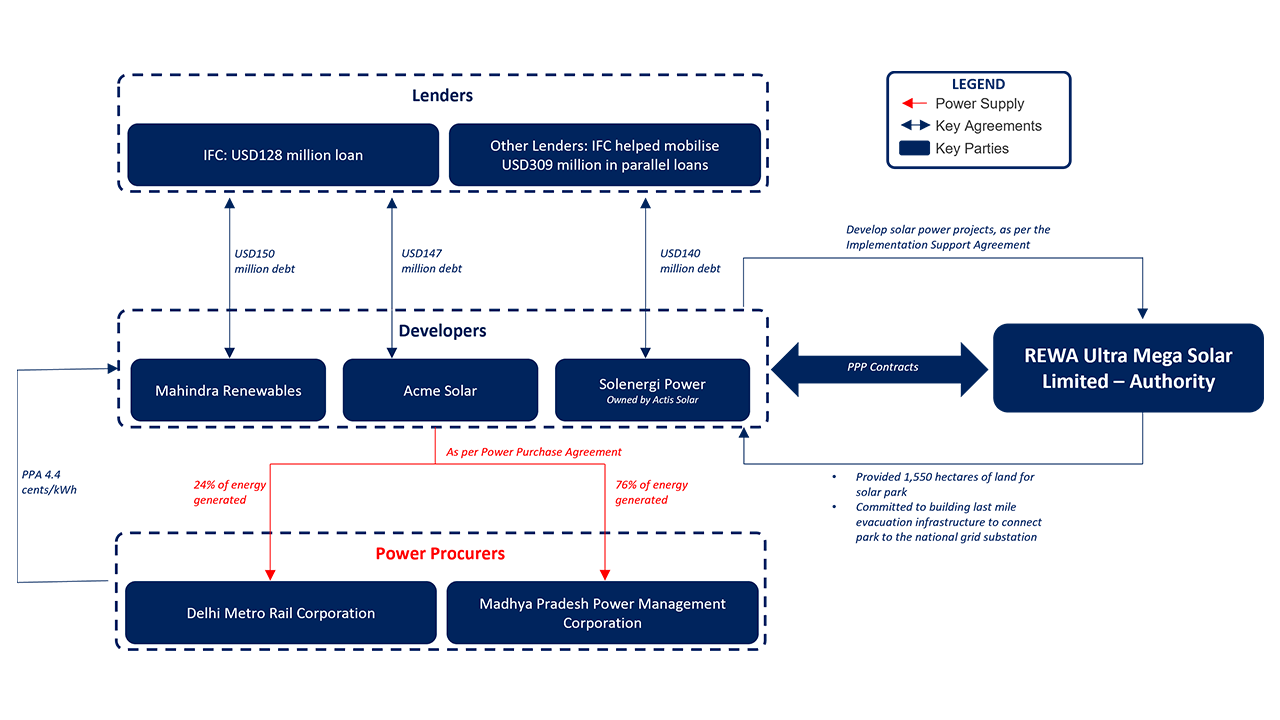Case studies
Publication Date
17 November 2021
Published
17 Nov 2021
REWA Solar Park
Context
- India launched its National Solar Mission in 2010, with the goal of adding 100GW of solar power by 2022.
- The government of India has used a solar park model, which involves clustering solar producers in adjacent land lots that benefit from shared external transmission links, and internal evacuation infrastructure.
Stakeholders involved
- Winning bidders for three units: Mahindra Renewables, Acme Solar, and Solenergi Power
- Public partner company REWA Ultra Mega Solar Limited (RUMSL): Formed in 2015, RUMSL is a joint venture between the Madhya Pradesh Urja Vikas Nigam (owned by the Government of Madhya Pradesh) and Solar Energy Corporation of India (owned by the Government of India).
- Lender: IFC is a member of the World Bank Group and uses capital and expertise to create markets and opportunities in developing countries.
- Power procurers: Delhi Metro Rail Corporation (a large public institutional power consumer) and Madhya Pradesh Power Management Corporation (a public utility distributing power in the State)
Problem
- India has about 300 million people who lack access to electricity.
- By February 2018, only 20GW of solar power had been installed, and an investment of USD13 billion annually was required to meet the 2022 National Solar Mission target.
- Indians' reliance on biomass (such as firewood) has contributed to poor air quality and health hazards, making Indian cities some of the most polluted in the world.
Innovation
- IFC provided PPP transaction advisory services to RUMSL to conduct commercial, legal, and technical due diligence; simulate a financial model; design a transaction structure; and prepare bankable project agreements to mobilise large-scale private investment without viability gap funding / subsidy.
- IFC helped RUMSL develop the bid documents and design an algorithm for an innovative online auction process, which focused on maximising flexibility to encourage competition.
- IFC advised on an innovative win-win power scheduling agreement between the two procurers that enabled Delhi Metro to draw power flexibly to suit the variable nature of its demand for running trains. This was the first time this form of agreement was made in the Indian electricity market. The transaction leveraged India’s open access rules to enable solar power transmission across state boundaries to run trains in the national capital.
Timeline



Results and impact
- The lowest ever tariff awarded for a solar PPP in India (without viability gap funding provided by the government) of 4.4 US cents per kWh. At this price, grid parity was reached, meaning the solar power was as affordable as other conventional power generation methods such as coal.
- The project generated up to USD575 million in private investment in Madhya Pradesh, traditionally a low-income state.
- The National Solar Bidding Guidelines, published by the Ministry of New and Renewable Energy, used several of the project structuring elements of the REWA solar park.
- The project reduced greenhouse gas emissions by 1 million tonnes per year.
- In all, 24% of the power generated will go to the Delhi Metro Rail Corporation, and the remaining 76% to Madhya Pradesh Power Management Corporation.
Key lessons learnt
- Preparing projects thoroughly to de-risk them and make them investment-ready prior to tendering enables large-scale commercial financing at lower cost, thereby enabling lower tariff.
- Integrating higher credit worthy institutional procurers such as Delhi Metro alongside a state-owned energy utility (MP Power Management Company) enhances the overall attractiveness of the transaction to investors and financiers, if properly structured.
- Maximising flexibility in an online reverse auction process can lead to increased competition and lower tariffs. The rule included using the lowest tariff proposed at the time of bid submission as the base price for the reverse auction.

